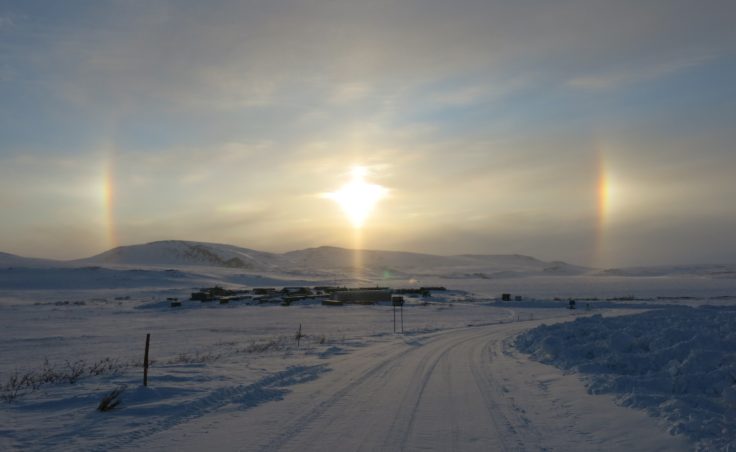Despite a wind that makes today’s minus 14 degrees Fahrenheit feel like minus 39, a worker at this research camp in blue-white hills north of the Brooks Range has proclaimed this the first day of summer.
Today, the population of Toolik Field Station increases from nine — five people running the camp, three scientists and me — to 16. Seven support staff members are making the 10-hour drive north from Fairbanks. Starting tomorrow, Toolik Field Station will be in summer mode until September. During the next few months people will sleep in dorm-style buildings, weatherports and tents as they study ground squirrels, permafrost, plants, fish and other far-north mysteries. At the peak of action here in mid-July, more than 100 scientists will clomp the gravel in rubber boots.
People have pondered things here on the treeless tundra since 1975, when the National Science Foundation funded research on nearby Toolik Lake, a splotch on the map that takes up more than a square mile. From a 16-foot travel trailer that now rests behind a heated outhouse, the camp has expanded to a few dozen structures, including a comfortable new dining hall/office building. Toolik Field Camp is part of the Institute of Arctic Biology at the University of Alaska Fairbanks. A few UAF staff members and logistics contract workers have kept the camp open all winter, even when the sun didn’t pop above the Brooks Range from late November until mid-January.
The existence of this place with warm beds, wireless internet, spare ribs on the dinner menu and people who are happy to dig out your cached snowmachine sleds has made for a pleasant start to an expedition during which scientists are studying the ubiquitous arctic lake.
Ben Jones of the USGS Alaska Science Center in Anchorage invited me along on a round-trip snowmachine journey from Toolik Lake to Teshekpuk Lake. For the past few days, he and his partners — Chris Arp of UAF’s Water and Environmental Research Center and Guido Grosse of the Alfred Wegener Institute in Germany and UAF’s Geophysical Institute — have used their impressive memories and navigational skills to motor out on near featureless tundra to the six lakes they are studying nearby, one of which is Toolik Lake.
They drilled soccerball-size holes in each of the lakes, recorded the thickness of the ice and were somewhat surprised at the splash of algae-speckled water in a few they thought would be frozen to the bottom. Discoveries like those are what the researchers wanted to find out as part of an arcticwide survey of lakes, which cover a good portion of the map up here.
With their work near done here at Toolik, the trio of scientists (and me) will soon pack up two sleds apiece and drive four ski doo Skandics down the frozen outlet stream from the lake. Jones will guide us over windblown bumps and smooth powder to a small encampment at Umiat on the Colville River, about 100 untracked miles away. There, we’ll continue the routine of gathering water and snow samples while measuring ice thickness and repairing equipment like lake buoys that the researchers deployed in past Augusts, when they monitor these same lakes by float plane.
This is the third straight year the scientists have made this three-week, 800-mile snowmachine traverse to sample the same few dozen lakes while another team does a similar science traverse from Barrow.
Funders at the National Science Foundation are interested in the lakes because they cover so much of the Arctic and the lakes are changing so quickly after perhaps being stable for thousands of years.
Because it’s getting too crowded here (and Ben, Chris and Guido have finished their work) I’ll send my next column from somewhere even more remote than Toolik Field Station. Follow the trip here in the weekly column and at alaskatracks.blogspot.com and Arctic Lakes blog. Ben carries a GPS that tracks us here.
Original publish date: April 9, 2014 | Since the late 1970s, the University of Alaska Fairbanks’s Geophysical Institute has provided this column free in cooperation with the UAF research community. Ned Rozell is a science writer for the Geophysical Institute.


